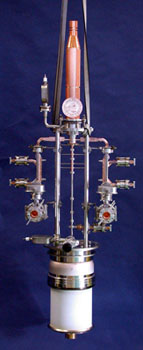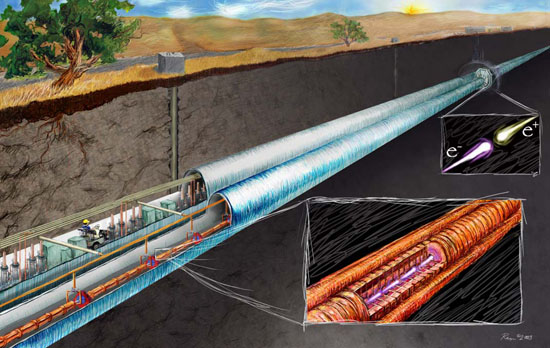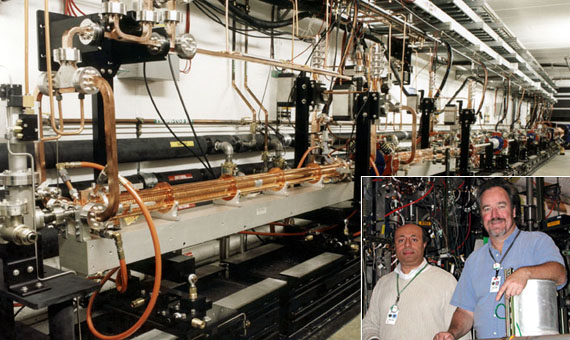 |
|
NLC Collaboration Reaches Critical High-Power
X-band Goal
by Heather Rock Woods MENLO PARK, California—A team at the Stanford Linear Accelerator cleared an important hurdle in December 2003 on the path to a next-generation global linear collider. The team, part of the U.S.-Japanese Next Linear Collider-Global Linear Collider collaboration, is working on X-band accelerator technology (for the so-called "warm" linear collider). The international particle physics community is also considering another technology option for the linear collider: superconducting radiofrequency technology, being pursued by the TESLA collaboration led by DESY in Germany.
"This was a real challenge. No one had pushed power this long, this hard and this high," said SLAC physicist David Schultz, who heads the 8-Pack Project. The International Linear Collider Technical Review Committee has rated the RF supply system as one of the two most critical goals to reach in order to consider building an X-band linear collider. The second critical goal involves the accelerating gradient of the RF structures. The physics community expects to select either an X-band collider or a superconducting collider by the end of this year. "This is a great step towards the full TeV-energy mission of the linear collider," said SLAC Professor David Burke, head of the NLC collaboration. On Dec. 4, SLAC Professor Sami Tantawi announced that the innovative RF supply station delivered the desired 475 MW / 400 ns pulse at a frequency of 11.424 gigahertz. Soon, the new system began routinely producing 570 MW. This is more than three times the peak RF power, and four times the frequency, that SLAC currently generates to run the world's longest and most powerful linear accelerator. Reaching this high-power goal was the culmination of an effort begun more than a decade ago as a collaboration between SLAC and KEK, Japan's High-Energy Accelerator Research Organization. "There were cheers all around, back-slapping and hand-shaking. This accomplishment was two years in the making," Schultz said.
An X-band collider would need over 2,000 such RF supply stations to add 65 mega-electron volts (MeV) of energy to an electron bunch for every meter the bunch travels. The second critical goal is to demonstrate the high-accelerating gradient performance (65 MeV per meter) of the accelerating RF cavities, the sophisticated, high-precision copper cells through which the electrons travel in a vacuum. A further test combining the high power with the accelerating structures will be carried out this spring at the NLC Test Accelerator. "We're enthusiastic about this next step—using the RF supply station to power the accelerating structures being built at Fermilab, SLAC and KEK," Burke said. In mid-January, the first of six RF accelerating structures to be supplied by Fermilab for the 8-Pack test was delivered to SLAC. Fermilab has also delivered several accelerating structures in the past for high-power RF testing in NLCTA. The eight-pack team designed and assembled a new, scaled-back RF system as an alternative to the original design, which required a pack of eight klystrons (the tubes that generate rf power). The current "8-Pack" station needs only four klystrons, which may be replaced this year with just two klystrons of a new design. One of these new 75 MW klystrons recently performed to full specifications for a warm linear collider.
The 8-Pack klystrons are powered by short, high-voltage pulses from a new modulator with pioneering solid-state switches. The RF power from the klystrons is funneled to a new SLED II (Stanford Linac Energy Doubler) system, which triples the power and shortens the pulse by a factor of four. Tantawi and his group designed revolutionary new components for the existing SLED system, enabling it to operate in "dual mode," where the RF power is transmitted in two modes to pack more power into a pulse in a shorter space. "We were rewarded when all these parts got integrated and operated together in perfect harmony," Tantawi said. "This machine is a beautiful work of art that gave its designers and creators a deep sense of satisfaction." Tantawi and Schultz are now running a series of performance tests to investigate whether the RF systems are sustainable and reliable under the operating conditions of a linear collider that runs around the clock. "We want to understand stability and other factors that are important if you need to build 2,000 of these," said Tantawi. On the Web:
Stanford Linear Accelerator Center |
| last modified 2/5/2004 email Fermilab |
FRLsDFx9eyfrPXgV


